Miriquidica nigroleprosa (Vain.) Hertel & Rambold var. liljenstroemii (Du Rietz) Owe-Larss. & Rambold
Bibl. Lichenol., 78: 355, 2001. Basionym: Lecidea liljenstroemii Du Rietz - Zur Methodologischen Grundlage der Modernen Pflanzensoziologie: 167, 1921.
Synonyms:
Distribution:
Description: Thallus crustose, episubstratic, pale grey to grey-white, dull, areolate, usually >1 mm thick, often forming large patches. Areoles dispersed or contiguous on a dark hypothallus, convex, 0.2-1.9 mm wide, consisting of 0.1-0.2 mm wide granules, often sorediate in marginal parts; soralia flat to finally convex (rarely concave), sometimes confluent, black to dark bluish grey; soredia 20-40 μm in diam. Cortex well-developed, olive-green to olive-brown, 5-25 μm thick, overlain by a distinct epinecral layer; medulla white, I-. Apothecia rare, 0.4-1.5 mm across, mostly subimmersed to subsessile, purple-black, with a flat to convex, epruinose disc and a usually prominent, persistent proper margin. Proper exciple dark olive-green to olive-brown in outer part, colourless within; epithecium olive-green; hymenium colourless, 40-70(-100) μm high; paraphyses usually simple or sparingly branched in upper part, c. 1.5 μm thick at mid-level, the apical cells up to 4-4.5 μm wide; hypothecium colourless. Asci 8-spored, clavate, approaching the Lecanora-type, but with a weakly amyloid tholus, lacking an amyloid zone above the axial body and with a thin outer amyloid wall layer. Ascospores 1-celled, hyaline, oblong, (7-)12-15 x 4-5(-6) μm. Pycnidia black, immersed in the areoles. Conidia thread-like, more or less curved, (7-)11-28(-30) x 0.5-1 μm. Photobiont chlorococcoid. Spot tests: medulla and soredia K-, C-, KC-, P+ yellow or more rarely P-; soredia N+ violet. Chemistry: miriquidic, often with additional psoromic acid. Note: this variety differs from var. nigroleprosa in the whitish to pale grey, dull thallus consisting of thick, contiguous areoles with convex soralia, and in the secondary chemistry (it often contains psoromic additional to miriquidic acid, and therefore the medulla often reacts P+ yellow); on siliceous rocks, in the Alps often in Rhizocarpon alpicola-communities; widespread in Europe but often not distinguished; in the Alps mainly known from the subalpine to the lower alpine belt; to be looked for in the Italian Alps.
Growth form: Crustose
Substrata: rocks
Photobiont: green algae other than Trentepohlia
Reproductive strategy: mainly asexual, by soredia, or soredia-like structures (e.g. blastidia)
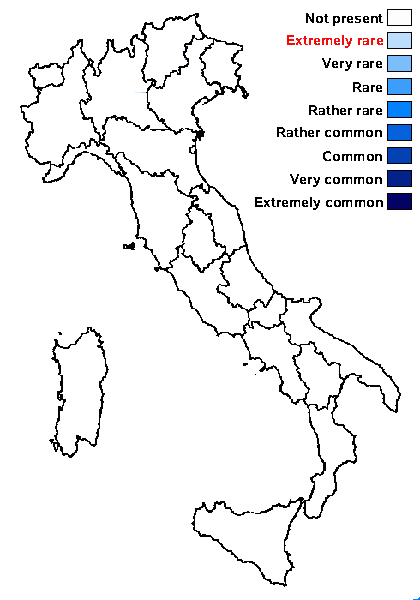
Predictive model
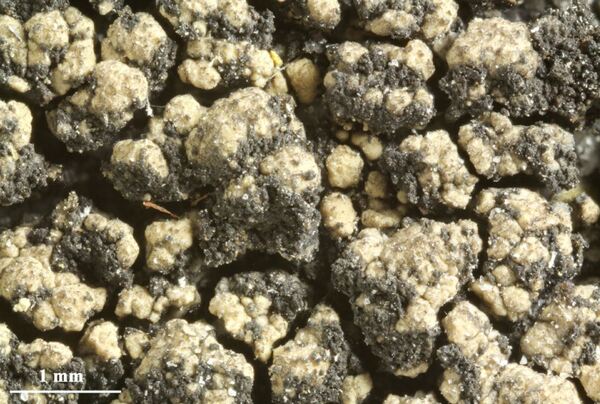
Felix Schumm- CC BY-SA 4.0
[19722], Germany, the Federal State of Lower Saxony, Harz National Park, west of St. Andreasberg, southeast slope of the moutain range ‘Acker’, Goldenkerklippen, 800m, on quarzite, TK 4228. Leg. H. Ullrich & J. Poelt, 21.10.1967, det. A. Seelemann 27.05.2013. Dubl. aus dem Herbar des Nationalparks Harz (2066b).
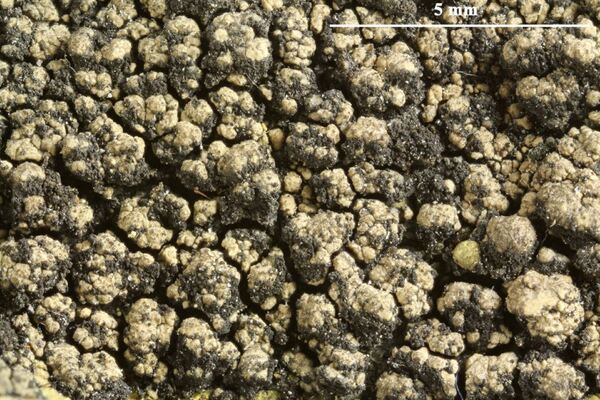
Felix Schumm- CC BY-SA 4.0
[19722], Germany, the Federal State of Lower Saxony, Harz National Park, west of St. Andreasberg, southeast slope of the moutain range ‘Acker’, Goldenkerklippen, 800m, on quarzite, TK 4228. Leg. H. Ullrich & J. Poelt, 21.10.1967, det. A. Seelemann 27.05.2013. Dubl. aus dem Herbar des Nationalparks Harz (2066b).
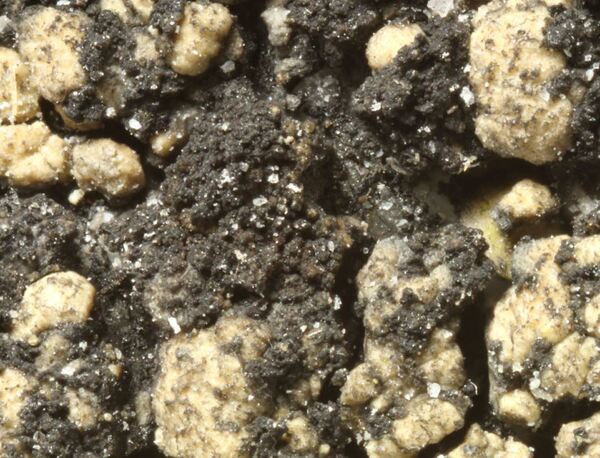
Felix Schumm- CC BY-SA 4.0
[19722], Germany, the Federal State of Lower Saxony, Harz National Park, west of St. Andreasberg, southeast slope of the moutain range ‘Acker’, Goldenkerklippen, 800m, on quarzite, TK 4228. Leg. H. Ullrich & J. Poelt, 21.10.1967, det. A. Seelemann 27.05.2013. Dubl. aus dem Herbar des Nationalparks Harz (2066b).
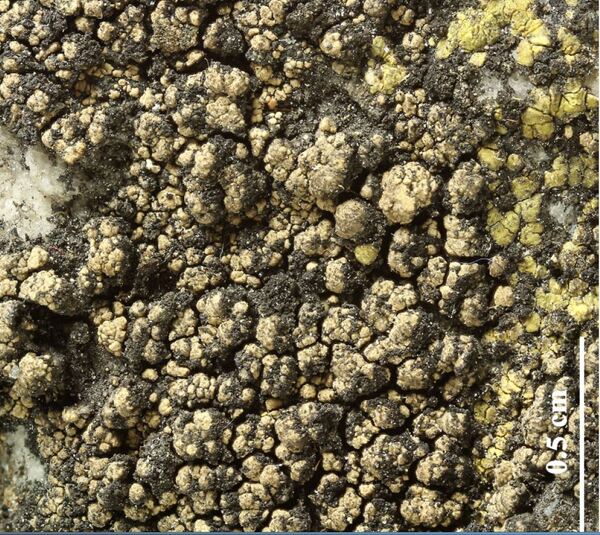
Felix Schumm- CC BY-SA 4.0
[19722], Germany, the Federal State of Lower Saxony, Harz National Park, west of St. Andreasberg, southeast slope of the moutain range ‘Acker’, Goldenkerklippen, 800m, on quarzite, TK 4228. Leg. H. Ullrich & J. Poelt, 21.10.1967, det. A. Seelemann 27.05.2013. Dubl. aus dem Herbar des Nationalparks Harz (2066b).
Growth form: Crustose
Substrata: rocks
Photobiont: green algae other than Trentepohlia
Reproductive strategy: mainly asexual, by soredia, or soredia-like structures (e.g. blastidia)

Predictive model

Felix Schumm- CC BY-SA 4.0
[19722], Germany, the Federal State of Lower Saxony, Harz National Park, west of St. Andreasberg, southeast slope of the moutain range ‘Acker’, Goldenkerklippen, 800m, on quarzite, TK 4228. Leg. H. Ullrich & J. Poelt, 21.10.1967, det. A. Seelemann 27.05.2013. Dubl. aus dem Herbar des Nationalparks Harz (2066b).

Felix Schumm- CC BY-SA 4.0
[19722], Germany, the Federal State of Lower Saxony, Harz National Park, west of St. Andreasberg, southeast slope of the moutain range ‘Acker’, Goldenkerklippen, 800m, on quarzite, TK 4228. Leg. H. Ullrich & J. Poelt, 21.10.1967, det. A. Seelemann 27.05.2013. Dubl. aus dem Herbar des Nationalparks Harz (2066b).

Felix Schumm- CC BY-SA 4.0
[19722], Germany, the Federal State of Lower Saxony, Harz National Park, west of St. Andreasberg, southeast slope of the moutain range ‘Acker’, Goldenkerklippen, 800m, on quarzite, TK 4228. Leg. H. Ullrich & J. Poelt, 21.10.1967, det. A. Seelemann 27.05.2013. Dubl. aus dem Herbar des Nationalparks Harz (2066b).

 INDEX FUNGORUM
INDEX FUNGORUM
 GBIF
GBIF

